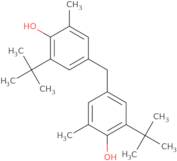4,4'-Methylenebis(2-tert-butyl-6-methylphenol)
CAS: 96-65-1
Rif. 3D-AAA09665
| 1g | Fuori produzione | ||
| 2g | Fuori produzione | ||
| 5g | Fuori produzione | ||
| 10g | Fuori produzione | ||
| 25g | Fuori produzione |
Informazioni sul prodotto
- 2,2′-Di-tert-Butyl-6,6′-dimethyl-4,4′-methylenediphenol
- 2-tert-Butyl-4-[(3-tert-butyl-4-hydroxy-5-methylphenyl)methyl]-6-methylphenol
- 4,4'-Methanediylbis(2-Tert-Butyl-6-Methylphenol)
- 4,4-Methylenebis(2-tert-butyl-6-methylphenol)
- 4,4′-Methylenebis(2-methyl-6-tert-butylphenol)
- 4,4′-Methylenebis(6-tert-butyl-2-methylphenol)
- 4,4′-Methylenebis[2-(1,1-dimethylethyl)-6-methylphenol]
- 4,4′-Methylenebis[6-tert-butyl-o-cresol]
- Di(3-tert-butyl-4-hydroxy-5-methylphenyl)methane
- Ethyl Antioxidant 720
- Vedi altri sinonimi
- NSC 67513
- Phenol, 4,4′-methylenebis[2-(1,1-dimethylethyl)-6-methyl-
- o-Cresol, 4,4′-methylenebis[6-tert-butyl-
4,4'-Methylenebis(2-tert-butyl-6-methylphenol) (MBP) is a divalent, aliphatic, sulfur, anti-oxidant. It is a phenolic antioxidant that can be used as a polymerization inhibitor and viscosity modifier. The disulfide groups in MBP react with metal ions to form metal complexes that are insoluble and can be easily removed from the system. It has been shown to provide protection against chloroprene degradation in rubber and polystyrene. 4,4'-Methylenebis(2-tert-butyl-6-methylphenol) also has the ability to reduce the viscosity of polyvinylchloride.





